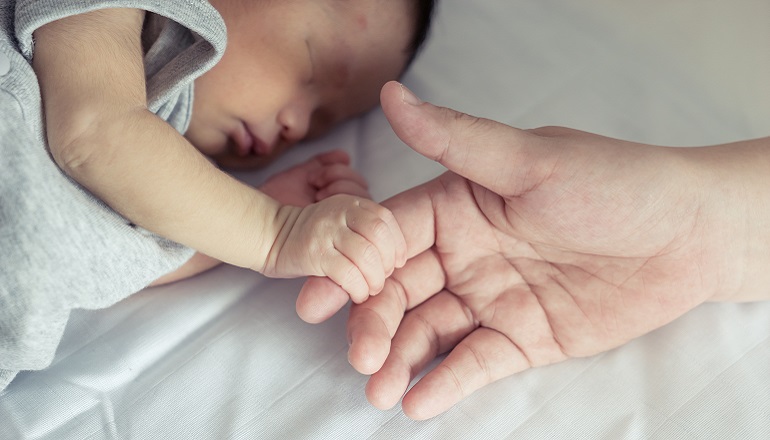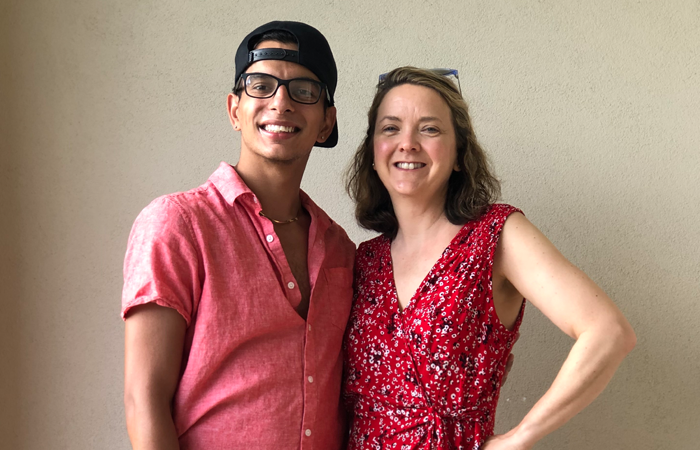“My husband and I hadn’t done any research on bonding issues, and once I held my daughter, all worry melted away. We facilitated bonding by what came naturally: holding her, singing to her, touching her, talking with her and cuddling her. Of course, we fed, changed and burped her too. Many books say that you shouldn’t pick up your baby every time she cries, lest she become spoiled. But when our daughter cried, we went to her. We felt it was important to let her know that we would meet her needs consistently. We quickly learned that our daughter doesn’t cry for no reason, and once we figured out what her need was (and met it) then the tears would stop. Our efforts have truly paid off: our girl is very happy, amiable and peaceful.” —Aaryn Belfer
“When I got a call saying that there was a baby available, the due date was just days away, and it was a boy, I was worried. How would I bond? Could I be the single mother of a boy? On the plane to Hawaii, I was happy, but anxious. After we left the hospital, we were alone in a hotel room for about 10 days, and it was there we really bonded. I gave him lots of kisses when bathing, feeding, and cuddling him. I talked to him constantly. I read to him. I told him I loved him about one hundred times a day. Two years later, he loves to hug and give kisses!” —Sharon Werhel, King of Prussia, PA
“While we were making plans to adopt internationally, our agency called to tell us about a birth mother who lived nearby. Although we had decided against domestic adoption, mostly due to ignorance, we felt compelled to pursue this. Caleb’s birth mother chose us the next day, and Caleb was born the day after. We had less than two days to prepare to be parents, so we relied heavily on our instincts. We made sure Caleb was in a soothing environment. I fed Caleb close to me, and rarely let others feed him. I bathed with Caleb, sang, made eye contact, the things that every healthy mom does with her baby. We did what felt right and kept our home our sanctuary.” —Christine Jorgens, Kaikua, Hawaii
“We were very fortunate to spend spent a great deal of time with our daughter’s birth parents before her birth. She was first placed in foster care, where we visited her frequently so that by the time she came home, we had bonded already. To help her become comfortable in her new surroundings, we brought familiar items like blankets, toys and clothes home from her foster home. We kept bottles, diapers, lotions and soaps, formula, and—most importantly routine the same. We had little difficulty with our daughter’s transition into our home.” —Lisa Sprink
“When we first made the decision to adopt, I will admit that I wondered whether the bond with my daughter would be as tight as I hoped. My wife’s bond with Olivia was dramatic and immediate. She cut the umbilical cord, helped weigh the baby in the nursery and took part in a lot of the ‘firsts’ at the hospital. My attachment grew to Olivia grew quickly because Olivia and I share special time together. Last night we sat quietly looking at our Christmas tree for about an hour. My favorite way of enhancing our bond is simply looking face-to-face with her, especially now that she’s learning to smile! As she has learned my voice, she looks for me when I speak to her.” —Craig Nelson, Normal, IL
Parents Share: “My Best Bonding Advice”]
“I adopted two sons as newborns. ‘Wearing’ the babies when they were little helped us to bond. With my second child, his big 3-year-old brother needed to bond as well, and I worried about that unnecessarily as it turned out. We flew to Texas to pick up Niki, and when the adoption workers brought the baby in, Benjamin screamed ‘our baby, finally our baby!’ He held bottles and helped with diapers and baths, and the bond between them is extraordinarily strong. I do keep working at it, reminding them that they will always have each other. At seven and four years now, they stick up for each other and nothing gets between them.” —Christina Brantner
“We adopted our son when he was a week old and we had a very easy bonding and attachment process. Two things we recommend: carrying your baby in a wrap-type carrier and taking an infant massage class with your baby. The versatility of the wrap facilitated eye contact and made it easy to take our son along, whatever we were doing. Infant massage was another wonderful way to experience eye contact and touching. Our son is four now but still enjoys a foot massage—and is even willing to reciprocate!” —Yasmin Haque, Hamden, CT
“When I adopted my youngest daughter domestically, attachment was difficult because she was hospitalized for three months. When she came home I bought a soft sling baby carrier. It allowed me to hold her close to my heart in a comforting fetal position for much of the day. Not only did this improve our attachment, it also improved her health immensely!” —Holly O’Brien
“As adoptive parents who already had a biological child, we were very concerned about how we would bond with our newly adopted baby, especially because he was coming to us at seven weeks old. I had nursed my daughter, and wondered how not having this bond with my son would affect attachment. What we did was to practice attachment parenting in as many ways as we could. We wore our son in a sling or a front carrier whenever possible. We slept with him. We rocked him and held him all the time. We used feeding time to make eye contact and interact with him. And since he was bottle-fed, my husband had just as many opportunities to bond with our son as I did.
I don’t think that our son could be any more attached than he is. My advice to other adoptive parents of newborns is the same advice I have for all parents of newborns: hold them all the time! They are tiny for such a short time. We rocked our daughter to sleep until she was four, and we still lie down with her at night. We intend to do the same with our son. Our daughter is almost ten now, and I can’t believe how quickly the time has flown by. Cherish every moment with your precious gift!” —Cindy Page, San Diego, CA
[Instant eBook: The Complete Guide to Talking About Adoption]
“Bonding with our child was a concern of mine even after my husband I were chosen as adoptive parents. It felt like something I could not control. My husband and I worked with a local agency hoping for a newborn adoption. While we waited, I read lots of books about bonding, and attended seminars and waiting-parent support groups.
The birth parents who eventually chose us invited me to be present in the room for our son’s birth. My husband and I were able to bathe, feed and care for our son in the nursery. We felt like our sons parents even before going home.
My suggestion for other adoptive parents is to know it is okay to respectfully ask the birth parents for something that you would like to participate in, like bathing, feeding, holding, visiting, or taking photographs of your child.” —A couple from Nebraska
“Although I knew I would love our new baby deeply, I was secretly worried that I would love my biological son more. Now that our daughter is home, it is hard to believe I ever felt that way! I am so attached to her and love her so deeply that I don’t know how I would cope if something ever happened to her. Destany slept in a cradle in our room until she was four months old. Now she shares a room with her big brother, and they are inseparable, and they both sleep better knowing the other is there.” —Kiara Howerzyl
“I have adopted domestically twice, in my experience, the sooner I held them, the sooner they felt like mine. Some ways to facilitate and speed the transition: Be at the delivery or as close to it as possible. Make sure your paperwork is processed and the hospital social worker is on board with the adoption process. This person is key to making the transition smooth, by, for example, granting your access into the nursery as soon as the baby is born. Do not leave this matter up to the agency or legal department. I recommend making direct contact with this person. Get as involved as possible with your birth mother throughout her pregnancy.” —Jean Jensen
“We adopted our son at three days old, and I wanted to share with him the closeness that comes with breastfeeding. With the help of a lactation consultant, I prepared to try to breastfeed by taking various medications in the months leading up to the adoption. When our son came home, we tried breastfeeding with a supplementation system for about a week. Although it didn’t work in the end, we had a special week of bonding time. And I know that inducing lactation can work!” —Melissa Clark, Chicago


